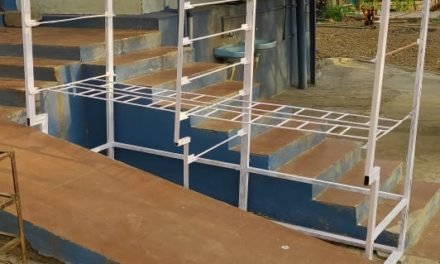BIOFLOC TECHNOLOGY
It is an innovative and cost-effective technology in which toxic materials to the fish and shellfish such as Nitrate, Nitrite, Ammonia can be converted to useful product, ie., proteinaceous feed.
It is the technology used in aquaculture system with limited or zero water exchange under high stocking density, strong aeration.

PROCEDURE
22/07/2022
First we cleaned area around tank
23/07/2022
Then measured total volume of water in tank as below

- Height of water in tank
h1=0.56, h2=0.62, h3=0.675, h4=0.64, h5=0.65(we calculated multiple values of height because height of water in tank is not uniform)
- Average value of height= 0.629m
- Radius of tank=1.9m
- Therefore volume of water in tank=π r² h
=3.14*1.9*1.9*0.629
=7cumec
=7000Litre
- For 7000L, 7 kg jaggery requires.


24/07/2022
We calculated jaggery and kept that jaggery to soak in water. Next day we dissolved this liquid in tank. We have use this jaggery as food feed for fishes.


Added 1 L culture in water tank. Which produces bacteria.
Then we measured total numbers of fishes =106, total weight of fishes=9.869 kg
We joined bubbler in system to provide aeration.



- 26/07/2022
- We removed MBBR(Moving Bed Biofilm Reactor) from old tanks. MBBR used for wastewater treatment.
Water from bio floc is supplied to aquaponics where, plant use some water and remaining is supplied back to bio floc. hence entire process is recyclable. There is no extra recharge of water.
Conclusion:
- The principle of this technique is generation of nitrogen cycle by maintaining higher C:N ratio. C:N ratio is maintained by addition of carbohydrates.
- In this system ammonia is converted into nitrite then into nitrates and finally in nitrogen. So we can say in bio floc system waste material of fishes is converted into feed so there is no need of extra feed material. This entire process saves cost of feed.
Benefits of Biofloc Technology
- Reduces extra use of feed.
2. Eco-friendly culture system.
3. It reduces environmental impact.
4. Improves land and water use efficiency
5. Limited or zero water exchange
6. Higher productivity (It enhances survival rate, growth performance, feed conversion in the culture systems of fish).
7. Cost-effective feed production.
Disadvantages:
- Increased energy requirement for mixing and aeration
- Increased pollution potential from nitrate accumulation
- Inconsistent and seasonal performance for sunlight-exposed systems.





